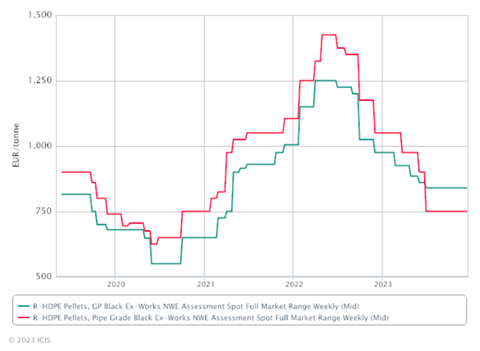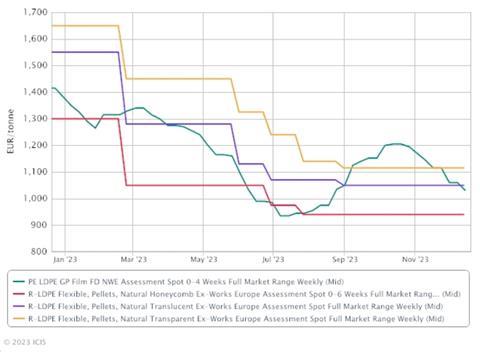
Various macroeconomic conditions were blamed for hindering trading conditions for recycled polyethylene last year. Mark Victory, senior recycling editor at ICIS, runs us through his predictions as to how the cost of living, incoming legislation, and other factors might continue to impact the prices and trade of recycled polymers in 2024.
The majority of players expect recycled polyethylene’s (rPE) tough trading conditions to continue into 2024 due to ongoing bearish macroeconomic conditions, although many expect this to improve compared with 2023.
Many are predicting that weak demand will continue across at least H1, and it will potentially not be until 2025 before the market sees a full-scale recovery, depending on the evolution of the cost-of-living crisis and the substitution pressure to virgin.
Some players in the recycled high-density polyethylene (rHDPE) market are hopeful of a slight bounce in Q1 – particularly players in packaging grades – as a result of restocking after the year end, and due to the resumption of several previously suspended packaging projects.
Nevertheless, the packaging sector remains more cost-sensitive than it has been for several years, while the end-use market in sectors such as construction, home improvement, and outdoor furniture – which continue to comprise the lion’s share of consumption – remains heavily negatively impacted by the cost-of-living crisis.
The European Parliament’s Autumn 2023 ‘Eurobarometer’ showed that 47% of Europeans have seen their standard of living reduced in 2023, with 37% having difficulties paying bills, and 73% expecting their standard of living to further decrease in the next 12 months.
While rHDPE has remained largely decoupled from virgin market movements, low virgin values have seen continued substitution pressure away from recycled material in 2023 – especially for non-packaging grades – and because of this, virgin price movements are expected to have an outsized impact on the rHDPE market in early 2024, compared to what is typical.
Construction remains the weakest end sector for demand and the most oversupplied, with the cost-of-living crisis continuing to blunt consumer demand and ongoing substitution pressure to virgin and off-spec material. In 2023, this saw pipe-grade black rHDPE pellets trade below general-purpose black pellets for the first time on record in June, where they have remained ever since.

While in the short-term market conditions are difficult, the market remains structurally short; coupled with this, 2023 has seen a rationalization of downstream supply, leading multiple players to expect that any recovery could have a swift and pronounced impact on market sentiment. Conditions remain volatile and difficult to predict.
Recycled low-density polyethylene (rLDPE) market participants are not anticipating any major surprises in the first part of 2024, but the outlook is quite subdued based on conversations taking place in December.
One particular area of interest for players in the rLDPE flexibles sector is the direction of virgin LDPE prices, and what impact that may have on demand for recycled material in the first half of the year. Virgin prices softened towards the end of 2023, and this has the potential to impact rLDPE flexible pellet demand in particular if virgin trends downwards into 2024. As of December, LDPE prices sat below both rLDPE flexible natural transparent and natural translucent pellet prices.

Higher-quality grades such as transparent pellets, often used in packaging and for its aesthetic qualities, may hold up better despite lower virgin prices as some companies may continue to utilize a certain percentage of recycled content to meet self-imposed sustainability targets, or want to market products as containing recycled material.
It may be the lower quality grades such as natural honeycomb rLDPE flexible pellets that feel the impact more if brands and fast-moving consumer goods companies (FMCGs) choose virgin material over recycled, especially if they find it easier to work with virgin material compared to rLDPE grades.
Regulation will play a part in discussions in the first part of the year as the draft Packaging and Packaging Waste Regulation (PPWR) is expected to pass into law in February, putting in place mandatory recycled content targets for all plastic packaging from 2030, as well as setting out laws for collection and sorting, and banning the use of certain plastics in the EU.
One area that the rLDPE market will be looking for clarity on is an amendment to Annex 5 of the original draft regulation that sets out rules for the use of shrink film. Concerns arise from changes to Annex V in relation to Article 22 - Restrictions on the use of certain packaging formats including shrink wrap, which is one of the end-use markets for rLDPE flexible pellets. In the latest round of amends, Amendment 328 changes Annex V to include plastic packaging used at ‘the point of sale’ - previously ‘retail level’ - and adds bottles to the list of grouped goods.
This could potentially mean that shrink wrap used to group items such as shampoo or cosmetic bottles together in ‘3-for-2’ bundles in supermarkets could be banned. However, as is always the case with regulation, there are provisions that may allow the use of shrink wrap outlined in the draft, including if 85% of the material can be collected for recycling, and if the alternative packaging types can be proven to have a higher environmental impact than the material they are replacing.
Both the original draft regulation published in November 2022 as well as the European Parliament’s Committee on Environment (ENVI) vote on proposed amends in October have caused a lot of confusion across the packaging market in general, and players will hope for much greater clarity before the final round of voting.
If you liked this article, you might also enjoy:
The Lidl approach to packaging sustainability
How did Brazil achieve its 100% aluminium can recycling rate – and can it be replicated in the EU?
Experts have their say on the EU’s Packaging and Packaging Waste Directive revisions
A deep dive into the most important packaging sustainability trends and solutions

















No comments yet